 W
WA wearable computer, also known as a wearable or body-borne computer, is a computing device worn on the body.
 W
WAn activity tracker, also known as a fitness tracker, is a device or application for monitoring and tracking fitness-related metrics such as distance walked or run, calorie consumption, and in some cases heartbeat. It is a type of wearable computer. The term is now primarily used for smartwatches that are synced, in many cases wirelessly, to a computer or smartphone for long-term data tracking. There are also independent mobile and Facebook apps. Some evidence has found that the use of these type of devices results in less weight loss rather than more. Sleep tracker devices have a tendency to underdetect wakefulness.
 W
WAsteroidOS is an open source operating system designed for smartwatches. It is available as a firmware replacement for some Android Wear devices. The motto for the AsteroidOS project is "Hack your wrist."
 W
WAutographer is a hands-free, wearable digital camera developed by OMG Life. The camera uses five different sensors to determine when to automatically take photos and can take up to 2,000 pictures a day. It was released in July 2013 and is used primarily for lifelogging, entertainment and travel. As of 16 October 2016, OMG Life, the company behind Autographer discontinued operations.
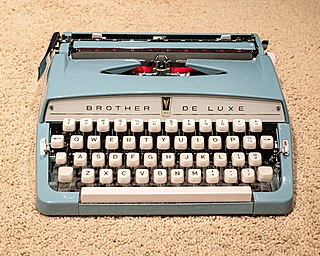 W
WBrother Industries, Ltd. is a Japanese multinational electronics and electrical equipment company headquartered in Nagoya, Japan. Its products include printers, multifunction printers, desktop computers, consumer and industrial sewing machines, large machine tools, label printers, typewriters, fax machines, and other computer-related electronics. Brother distributes its products both under its own name and under OEM agreements with other companies.
 W
WCasio Computer Co., Ltd. is a Japanese multinational consumer electronics and commercial electronics manufacturing company headquartered in Shibuya, Tokyo, Japan. Its products include calculators, mobile phones, digital cameras, electronic musical instruments, and analogue and digital watches. It was founded in 1946, and in 1957 introduced the world's first entirely electric compact calculator. It was an early digital camera innovator, and during the 1980s and 1990s the company developed numerous affordable home electronic keyboards for musicians along with introducing the world's first mass-produced digital watches.
 W
WCatapult is a sports performance analytics company, listed on the Australian Stock Exchange, that provides performance technology to 2970 teams, across 39 sports, in 137 countries. The company is headquartered in Melbourne, Australia.
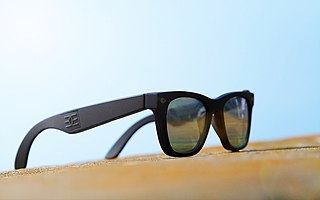 W
WEpiphany Eyewear are smartglasses developed by Vergence Labs. The glasses record video stored within the glasses' hardware for live-stream upload to a computer or social media. The glasses use smartphone technology. The head mounted display is a mobile computer and a high-definition camera. The glasses take photographic images, record or stream video to a smartphone or computer tablet.
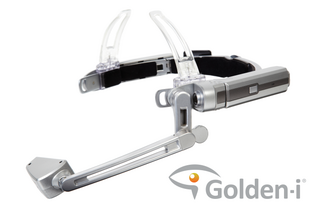 W
WDeveloped at Kopin Corporation by a team led by Jeffrey Jacobsen, Chief Golden-i Architect and Senior Advisor to CEO, the Golden-i platform consists of multiple mobile wireless wearable headset computers operated by voice commands and head movements. Utilizing a speech controlled user interface and head-tracking functionality, Golden-i enables the user to carry out common computer functions whilst keeping their hands free.
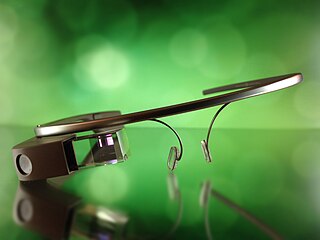 W
WGoogle Glass, or simply Glass, is a brand of smart glasses—an optical head-mounted display designed in the shape of a pair of eyeglasses. It was developed by X with the mission of producing a ubiquitous computer. Google Glass displays information in a smartphone-like, hands-free format. Wearers communicate with the Internet via natural language voice commands.
 W
WA head-mounted display (HMD) is a display device, worn on the head or as part of a helmet, that has a small display optic in front of one or each eye. An HMD has many uses including gaming, aviation, engineering, and medicine. Virtual reality headsets are HMDs combined with IMUs. There is also an optical head-mounted display (OHMD), which is a wearable display that can reflect projected images and allows a user to see through it.
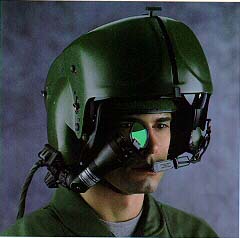 W
WA helmet-mounted display (HMD) is a device used in aircraft to project information to the pilot's eyes. Its scope is similar to that of head-up displays (HUD) on an aircrew's visor or reticle. An HMD provides the pilot with situation awareness, an enhanced image of the scene, and in military applications cue weapons systems, to the direction their head is pointing. Applications which allow cuing of weapon systems are referred to as helmet-mounted sight and display (HMSD) or helmet-mounted sights (HMS).
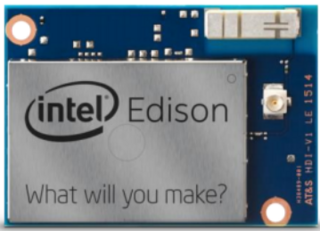 W
WThe Intel Edison is a computer-on-module that was offered by Intel as a development system for wearable devices and Internet of Things devices. The system was initially announced to be the same size and shape as an SD card and containing a dual-core Intel Quark x86 CPU at 400 MHz communicating via Bluetooth and Wi-Fi. A later announcement changed the CPU to a 500 MHz Silvermont dual-core Intel Atom CPU, and in September 2014 a second version of Edison was shown at IDF, which was bigger and thicker than a standard SD card.
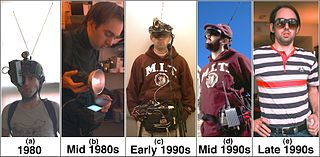 W
WA lifelog is a personal record of one’s daily life in a varying amount of detail, for a variety of purposes. The record contains a comprehensive dataset of a human's activities. The data could be used to increase knowledge about how people live their lives. In recent years, some lifelog data has been automatically captured by wearable technology or mobile devices. People who keep lifelogs about themselves are known as lifeloggers.
 W
WManufacture Modules Technologies Sarl (MMT) is a Swiss company established in Geneva in 2015 which originally specialised in the development and commercialization of "Horological Smartwatch modules", firmware, apps and cloud. Located at Geneva's Skylab high-tech hub, it expanded into the development and manufacturing of "E-Straps" operated with a mobile application.
 W
WMicrosoft's SenseCam is a lifelogging camera with fisheye lens and trigger sensors, such as accelerometers, heat sensing, and audio, invented by Lyndsay Williams, patent granted in 2009. Usually worn around the neck, Sensecam is used for the MyLifeBits project, a lifetime storage database. Early developers were James Srinivasan and Trevor Taylor.
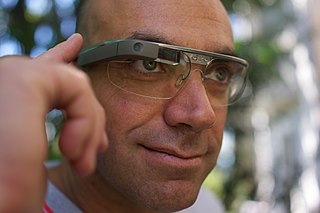 W
WAn optical head-mounted display (OHMD) is a wearable device that has the capability of reflecting projected images as well as allowing the user to see through it, similar to augmented reality technology. OHMD technology has existed since 1997 in various forms, but despite a number of attempts from industry, has yet to be commercialised.
 W
WA Peripheral Head-Mounted Display (PHMD) describes a visual display mounted to the user's head that is in the peripheral of the user's Field-of-View (FOV) / Peripheral Vision. Whereby the actual position of the mounting is considered to be irrelevant as long as it does not cover the entire FOV. While a PHMD provide an additional, always-available visual output channel, it does not limit the user performing real world tasks.
 W
WThe quantified self refers both to the cultural phenomenon of self-tracking with technology and to a community of users and makers of self-tracking tools who share an interest in “self-knowledge through numbers.” Quantified Self practices overlap with the practice of lifelogging and other trends that incorporate technology and data acquisition into daily life, often with the goal of improving physical, mental, and/or emotional performance. The widespread adoption in recent years of wearable fitness and sleep trackers such as the Fitbit or the Apple Watch, combined with the increased presence of Internet of Things in healthcare and in exercise equipment, have made self-tracking accessible to a large segment of the population.
 W
WRecon Instruments was a Canadian technology company that produced smartglasses and wearable displays marketed by the company as "heads-up displays" for sports. Recon's products delivered live activity metrics, GPS maps, and notifications directly to the user's eye. Recon's first heads-up display offering was released commercially in October 2010, roughly a year and a half before Google introduced Google Glass.
 W
WSmartglasses or smart glasses are wearable computer glasses that add information alongside or to what the wearer sees. Alternatively, smartglasses are sometimes defined as wearable computer glasses that are able to change their optical properties at runtime. Smart sunglasses which are programmed to change tint by electronic means are an example of the latter type of smartglasses.
 W
WA smartwatch is a wearable computer in the form of a watch; modern smartwatches provide a local touchscreen interface for daily use, while an associated smartphone app provides for management and telemetry. While early models could perform basic tasks, such as calculations, digital time telling, translations, and game-playing, 2010s smartwatches have more general functionality closer to smartphones, including mobile apps, a mobile operating system and WiFi/Bluetooth connectivity. Some smartwatches function as portable media players, with FM radio and playback of digital audio and video files via a Bluetooth headset. Some models, called 'watch phones', have mobile cellular functionality like making calls.
 W
WSpectacles are smartglasses dedicated to recording video for the Snapchat service. They feature a camera lens and are capable of recording short video segments and syncing with a smartphone to upload to the user's online account. They were developed and manufactured by Snap Inc., and announced on September 23, 2016. The smartglasses were released on November 10, 2016. They are made for Snap's image messaging and multimedia platform, Snapchat, and were initially distributed exclusively through Snap's pop-up vending machine, Snapbot. On February 20, 2017, Snap Spectacles became available for purchase online.
 W
WWear OS is a version of Google's Android operating system designed for smartwatches and other wearables. By pairing with mobile phones running Android version 6.0 or newer, or iOS version 10.0 or newer with limited support from Google's pairing application, Wear OS integrates Google Assistant technology and mobile notifications into a smartwatch form factor.
 W
WWearable technology, wearables, fashion technology, smartwear, tech togs, skin electronics or fashion electronics are smart electronic devices that are worn close to and/or on the surface of the skin, where they detect, analyze, and transmit information concerning e.g. body signals such as vital signs, and/or ambient data and which allow in some cases immediate biofeedback to the wearer.
 W
WThe Xiaomi Mi Band is a wearable activity tracker produced by Xiaomi, unveiled during a Xiaomi launch event on 22 July 2014.
 W
WThe Xiaomi Mi Band 2 is a low cost, wearable activity tracker produced by Xiaomi. It was released on 7 June, 2016. Unlike its predecessor, the Xiaomi Mi Band 2 comes with an OLED screen and a capacitive button. In September of 2017, Xiaomi released an ultra low-cost version of the Mi Band 2, titled "Mi Band - HRX Edition"
 W
WThe Xiaomi Mi Band 3 is a wearable activity tracker produced by Xiaomi Inc. It was released on 31 May 2018. It has a capacitive OLED display. The tracker features heart rate monitoring, although it does not offer continuous heart rate display.
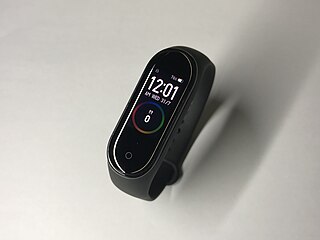 W
WThe Xiaomi Mi Band 4 is a wearable activity tracker produced by Xiaomi Inc released in China on 16 June 2019, in Europe on 26 June 2019 and in India on 19 September 2019. It is 39.9% larger than its predecessor, has a super capacitive AMOLED display and features 24/7 heart rate monitoring.
 W
WThe Xiaomi Mi Band 5 is a wearable activity tracker produced by Xiaomi Inc. It was announced in China on 11 June 2020, and went on sale on 18 June 2020 in China, with a Global version released on 15 July 2020 as Xiaomi Mi Smart Band 5. It is slated for release in India on 29th September, 2020. It has a 1.1-inch, 126x294 resolution capacitive AMOLED display and 24/7 heart rate monitoring claiming a 50% more accurate PPG sensor than its predecessor. It supports a charging dock that locates using a magnet which is said to be easier to use than previous generation chargers. The NFC-enabled version also has an in-built microphone for Xiaomi's in-built assistant Xiao.
 W
WZeo, Inc., formerly Axon Labs, was a private company founded by Brown University students. Established December 29, 2003 in Providence, Rhode Island and later headquartered in Boston, Massachusetts, it developed a smart alarm clock with sleep monitor. Sleep states could be used to sound a wake-up alarm only when the sleeper was in the light stages of sleep, likely to awake more refreshed. Details of sleep could be uploaded to the MyZeo Web site, where they were stored, with detailed historical charts of sleep patterns downloadable, and email suggestion on improving sleep could be sent. The state of sleep was detected by a headband, essentially comprising three long-lasting electrodes made of electrically conductive fabric and a wireless unit, that transmitted data to a Zeo bedside clock unit or Apple iPhone which displayed data and sounded the wake alarm. The company also developed and marketed a personal sleep coaching Web service which allowed users of the clock to upload their sleep data, then measure and analyze their sleep patterns; this was later made available without charge.